University of Bradford: SDG Business Case - Nature-Based Solutions
VerifiedAdded on 2023/01/05
|17
|4132
|41
Report
AI Summary
This report presents a business case analysis focusing on Nature-Based Solution projects aligned with the Sustainable Development Goals (SDGs). It evaluates three project proposals: Zajut Forest Reserve, Natural Wastewater Treatment (Babam), and Dig Irrigation System (Samboz), highlighting their financial aspects and strategic importance. The report details the US Agency for International Development (USAID)'s role in supporting these projects, emphasizing their strategic objectives: improving health benefits through sustainable Water, Sanitation, and Hygiene (WASH) and managing water in farming for enhanced food security. The analysis includes financial metrics such as Net Present Value (NPV), payback periods, and strategic approaches to achieve the outlined objectives. The report justifies the selection of the Natural Wastewater Treatment project based on its NPV and aligns the projects with USAID's overarching goals of promoting sustainable development, improving global health, and addressing environmental challenges. It further discusses the strategic approach, action plans, and the importance of sustainable water management. Finally, it provides a critical evaluation of the use of NPV in decision-making.
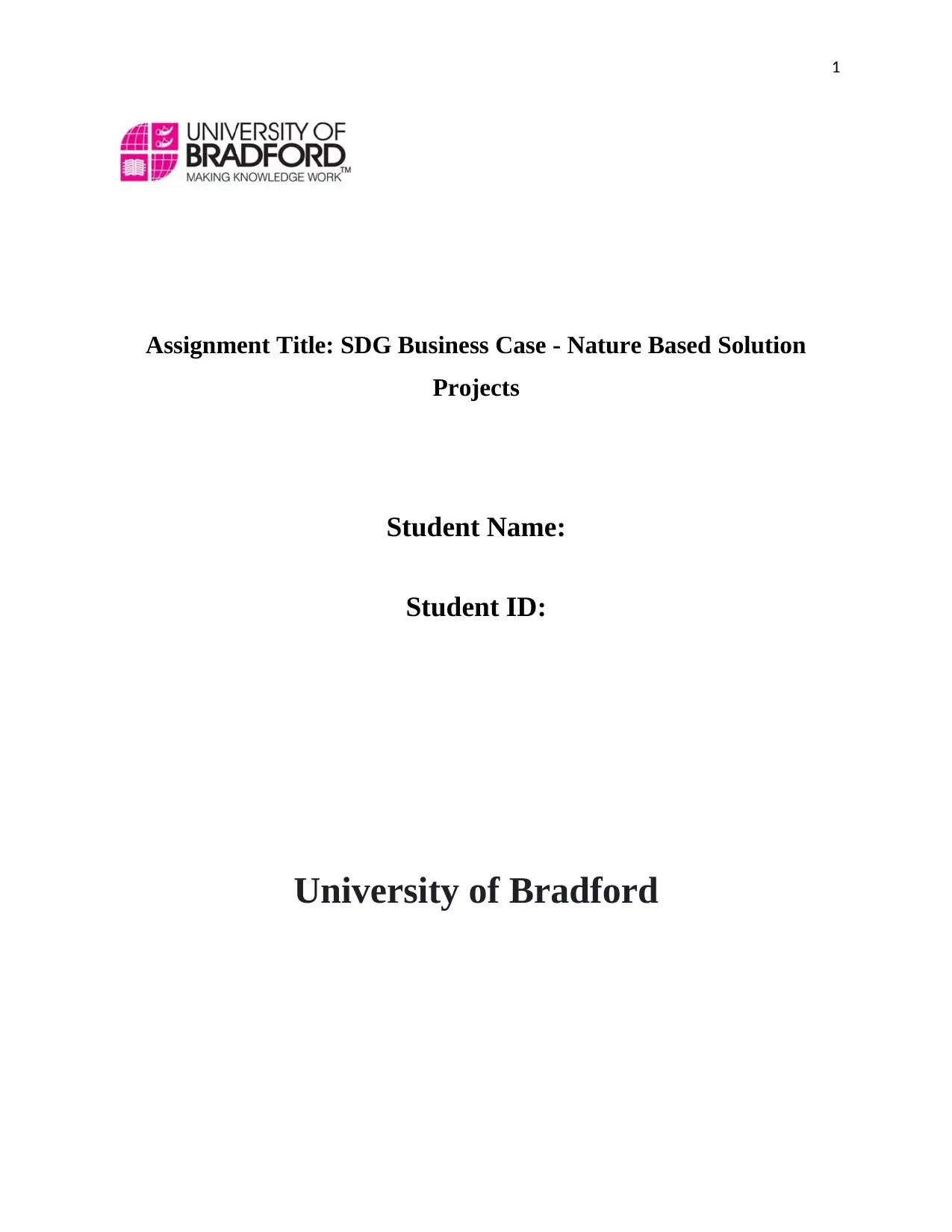
1
Assignment Title: SDG Business Case - Nature Based Solution
Projects
Student Name:
Student ID:
University of Bradford
Assignment Title: SDG Business Case - Nature Based Solution
Projects
Student Name:
Student ID:
University of Bradford
Paraphrase This Document
Need a fresh take? Get an instant paraphrase of this document with our AI Paraphraser
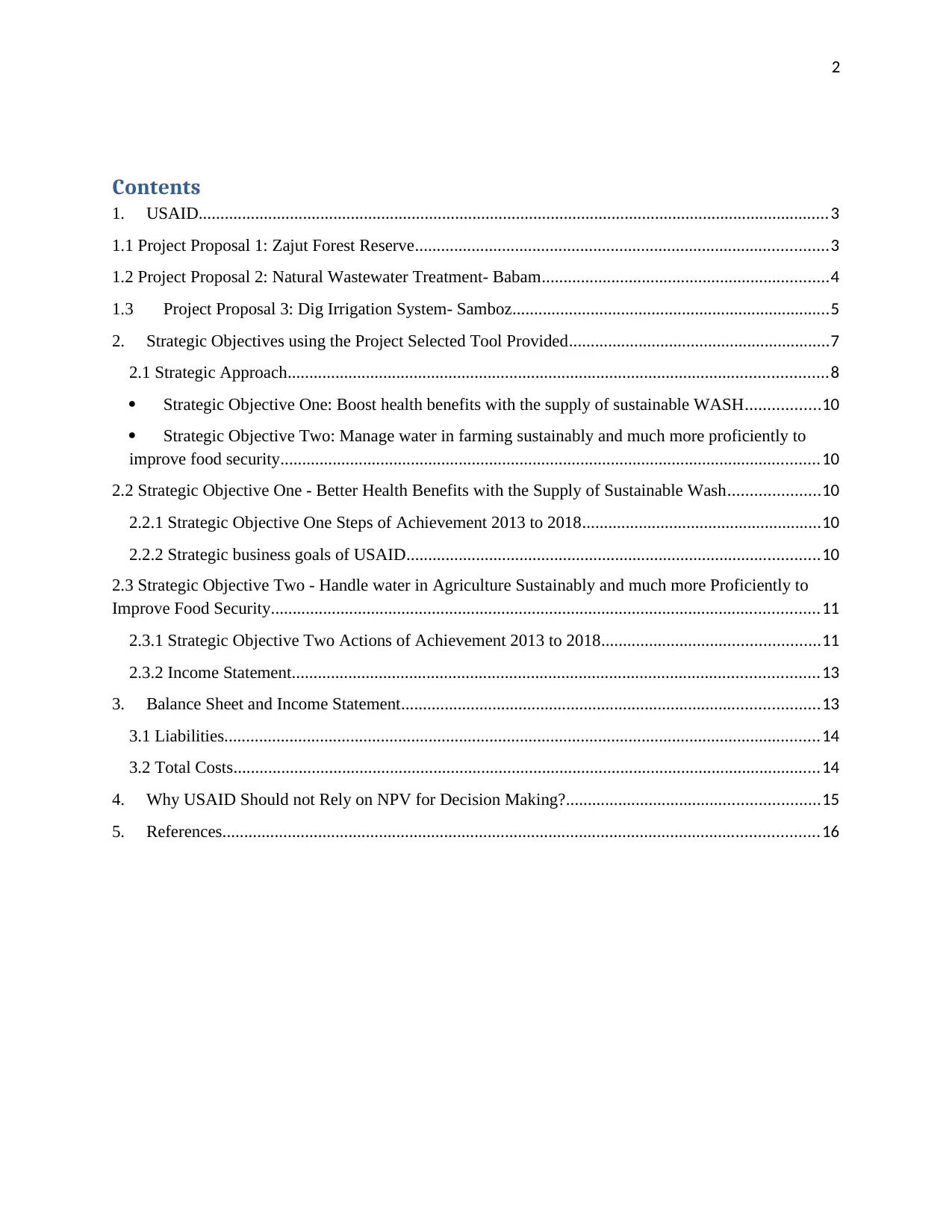
2
Contents
1. USAID.................................................................................................................................................3
1.1 Project Proposal 1: Zajut Forest Reserve...............................................................................................3
1.2 Project Proposal 2: Natural Wastewater Treatment- Babam..................................................................4
1.3 Project Proposal 3: Dig Irrigation System- Samboz.........................................................................5
2. Strategic Objectives using the Project Selected Tool Provided............................................................7
2.1 Strategic Approach............................................................................................................................8
Strategic Objective One: Boost health benefits with the supply of sustainable WASH.................10
Strategic Objective Two: Manage water in farming sustainably and much more proficiently to
improve food security............................................................................................................................10
2.2 Strategic Objective One - Better Health Benefits with the Supply of Sustainable Wash.....................10
2.2.1 Strategic Objective One Steps of Achievement 2013 to 2018.......................................................10
2.2.2 Strategic business goals of USAID...............................................................................................10
2.3 Strategic Objective Two - Handle water in Agriculture Sustainably and much more Proficiently to
Improve Food Security..............................................................................................................................11
2.3.1 Strategic Objective Two Actions of Achievement 2013 to 2018..................................................11
2.3.2 Income Statement.........................................................................................................................13
3. Balance Sheet and Income Statement................................................................................................13
3.1 Liabilities.........................................................................................................................................14
3.2 Total Costs.......................................................................................................................................14
4. Why USAID Should not Rely on NPV for Decision Making?..........................................................15
5. References.........................................................................................................................................16
Contents
1. USAID.................................................................................................................................................3
1.1 Project Proposal 1: Zajut Forest Reserve...............................................................................................3
1.2 Project Proposal 2: Natural Wastewater Treatment- Babam..................................................................4
1.3 Project Proposal 3: Dig Irrigation System- Samboz.........................................................................5
2. Strategic Objectives using the Project Selected Tool Provided............................................................7
2.1 Strategic Approach............................................................................................................................8
Strategic Objective One: Boost health benefits with the supply of sustainable WASH.................10
Strategic Objective Two: Manage water in farming sustainably and much more proficiently to
improve food security............................................................................................................................10
2.2 Strategic Objective One - Better Health Benefits with the Supply of Sustainable Wash.....................10
2.2.1 Strategic Objective One Steps of Achievement 2013 to 2018.......................................................10
2.2.2 Strategic business goals of USAID...............................................................................................10
2.3 Strategic Objective Two - Handle water in Agriculture Sustainably and much more Proficiently to
Improve Food Security..............................................................................................................................11
2.3.1 Strategic Objective Two Actions of Achievement 2013 to 2018..................................................11
2.3.2 Income Statement.........................................................................................................................13
3. Balance Sheet and Income Statement................................................................................................13
3.1 Liabilities.........................................................................................................................................14
3.2 Total Costs.......................................................................................................................................14
4. Why USAID Should not Rely on NPV for Decision Making?..........................................................15
5. References.........................................................................................................................................16
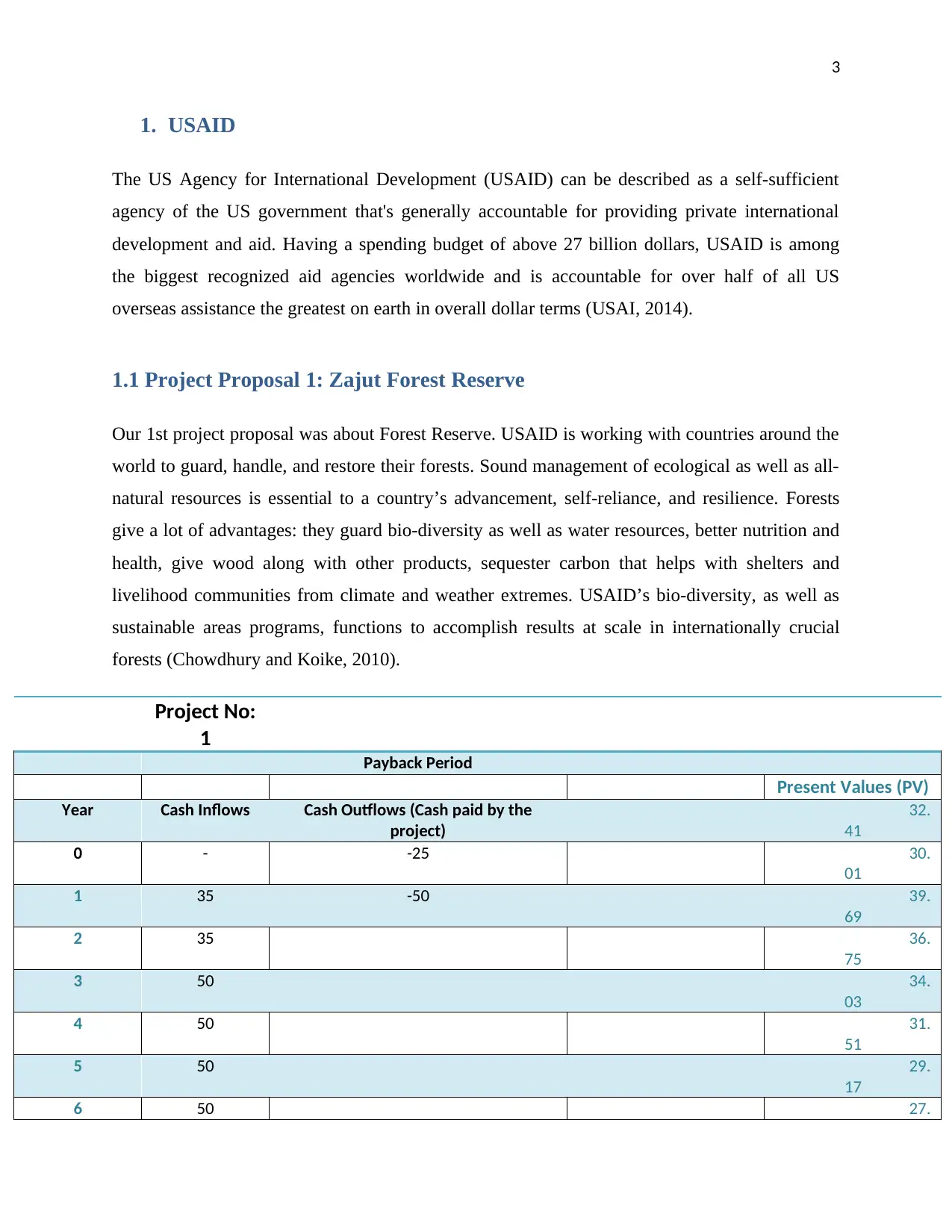
3
1. USAID
The US Agency for International Development (USAID) can be described as a self-sufficient
agency of the US government that's generally accountable for providing private international
development and aid. Having a spending budget of above 27 billion dollars, USAID is among
the biggest recognized aid agencies worldwide and is accountable for over half of all US
overseas assistance the greatest on earth in overall dollar terms (USAI, 2014).
1.1 Project Proposal 1: Zajut Forest Reserve
Our 1st project proposal was about Forest Reserve. USAID is working with countries around the
world to guard, handle, and restore their forests. Sound management of ecological as well as all-
natural resources is essential to a country’s advancement, self-reliance, and resilience. Forests
give a lot of advantages: they guard bio-diversity as well as water resources, better nutrition and
health, give wood along with other products, sequester carbon that helps with shelters and
livelihood communities from climate and weather extremes. USAID’s bio-diversity, as well as
sustainable areas programs, functions to accomplish results at scale in internationally crucial
forests (Chowdhury and Koike, 2010).
Project No:
1
Payback Period
Present Values (PV)
Year Cash Inflows Cash Outflows (Cash paid by the
project)
32.
41
0 - -25 30.
01
1 35 -50 39.
69
2 35 36.
75
3 50 34.
03
4 50 31.
51
5 50 29.
17
6 50 27.
1. USAID
The US Agency for International Development (USAID) can be described as a self-sufficient
agency of the US government that's generally accountable for providing private international
development and aid. Having a spending budget of above 27 billion dollars, USAID is among
the biggest recognized aid agencies worldwide and is accountable for over half of all US
overseas assistance the greatest on earth in overall dollar terms (USAI, 2014).
1.1 Project Proposal 1: Zajut Forest Reserve
Our 1st project proposal was about Forest Reserve. USAID is working with countries around the
world to guard, handle, and restore their forests. Sound management of ecological as well as all-
natural resources is essential to a country’s advancement, self-reliance, and resilience. Forests
give a lot of advantages: they guard bio-diversity as well as water resources, better nutrition and
health, give wood along with other products, sequester carbon that helps with shelters and
livelihood communities from climate and weather extremes. USAID’s bio-diversity, as well as
sustainable areas programs, functions to accomplish results at scale in internationally crucial
forests (Chowdhury and Koike, 2010).
Project No:
1
Payback Period
Present Values (PV)
Year Cash Inflows Cash Outflows (Cash paid by the
project)
32.
41
0 - -25 30.
01
1 35 -50 39.
69
2 35 36.
75
3 50 34.
03
4 50 31.
51
5 50 29.
17
6 50 27.
⊘ This is a preview!⊘
Do you want full access?
Subscribe today to unlock all pages.

Trusted by 1+ million students worldwide
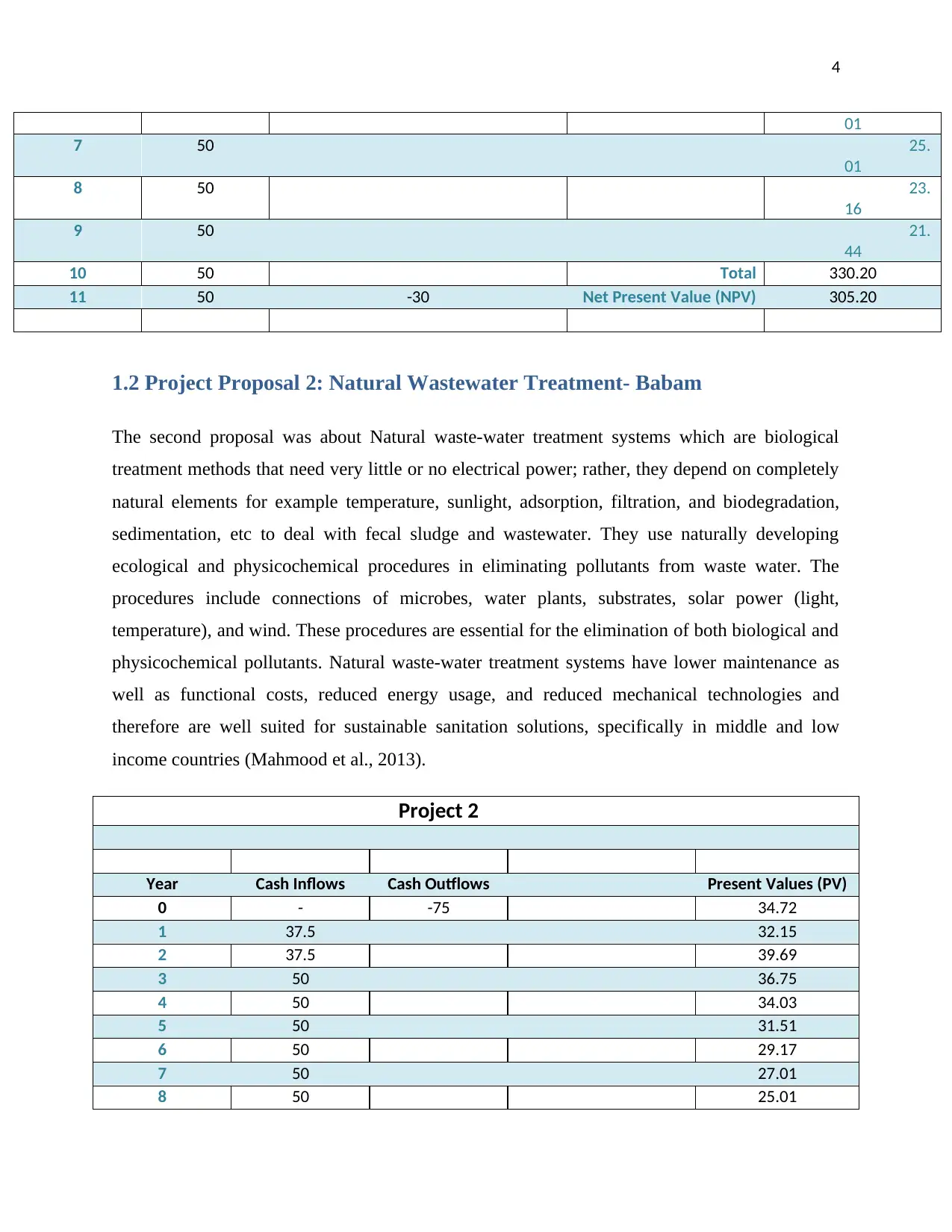
4
01
7 50 25.
01
8 50 23.
16
9 50 21.
44
10 50 Total 330.20
11 50 -30 Net Present Value (NPV) 305.20
1.2 Project Proposal 2: Natural Wastewater Treatment- Babam
The second proposal was about Natural waste-water treatment systems which are biological
treatment methods that need very little or no electrical power; rather, they depend on completely
natural elements for example temperature, sunlight, adsorption, filtration, and biodegradation,
sedimentation, etc to deal with fecal sludge and wastewater. They use naturally developing
ecological and physicochemical procedures in eliminating pollutants from waste water. The
procedures include connections of microbes, water plants, substrates, solar power (light,
temperature), and wind. These procedures are essential for the elimination of both biological and
physicochemical pollutants. Natural waste-water treatment systems have lower maintenance as
well as functional costs, reduced energy usage, and reduced mechanical technologies and
therefore are well suited for sustainable sanitation solutions, specifically in middle and low
income countries (Mahmood et al., 2013).
Project 2
Year Cash Inflows Cash Outflows Present Values (PV)
0 - -75 34.72
1 37.5 32.15
2 37.5 39.69
3 50 36.75
4 50 34.03
5 50 31.51
6 50 29.17
7 50 27.01
8 50 25.01
01
7 50 25.
01
8 50 23.
16
9 50 21.
44
10 50 Total 330.20
11 50 -30 Net Present Value (NPV) 305.20
1.2 Project Proposal 2: Natural Wastewater Treatment- Babam
The second proposal was about Natural waste-water treatment systems which are biological
treatment methods that need very little or no electrical power; rather, they depend on completely
natural elements for example temperature, sunlight, adsorption, filtration, and biodegradation,
sedimentation, etc to deal with fecal sludge and wastewater. They use naturally developing
ecological and physicochemical procedures in eliminating pollutants from waste water. The
procedures include connections of microbes, water plants, substrates, solar power (light,
temperature), and wind. These procedures are essential for the elimination of both biological and
physicochemical pollutants. Natural waste-water treatment systems have lower maintenance as
well as functional costs, reduced energy usage, and reduced mechanical technologies and
therefore are well suited for sustainable sanitation solutions, specifically in middle and low
income countries (Mahmood et al., 2013).
Project 2
Year Cash Inflows Cash Outflows Present Values (PV)
0 - -75 34.72
1 37.5 32.15
2 37.5 39.69
3 50 36.75
4 50 34.03
5 50 31.51
6 50 29.17
7 50 27.01
8 50 25.01
Paraphrase This Document
Need a fresh take? Get an instant paraphrase of this document with our AI Paraphraser
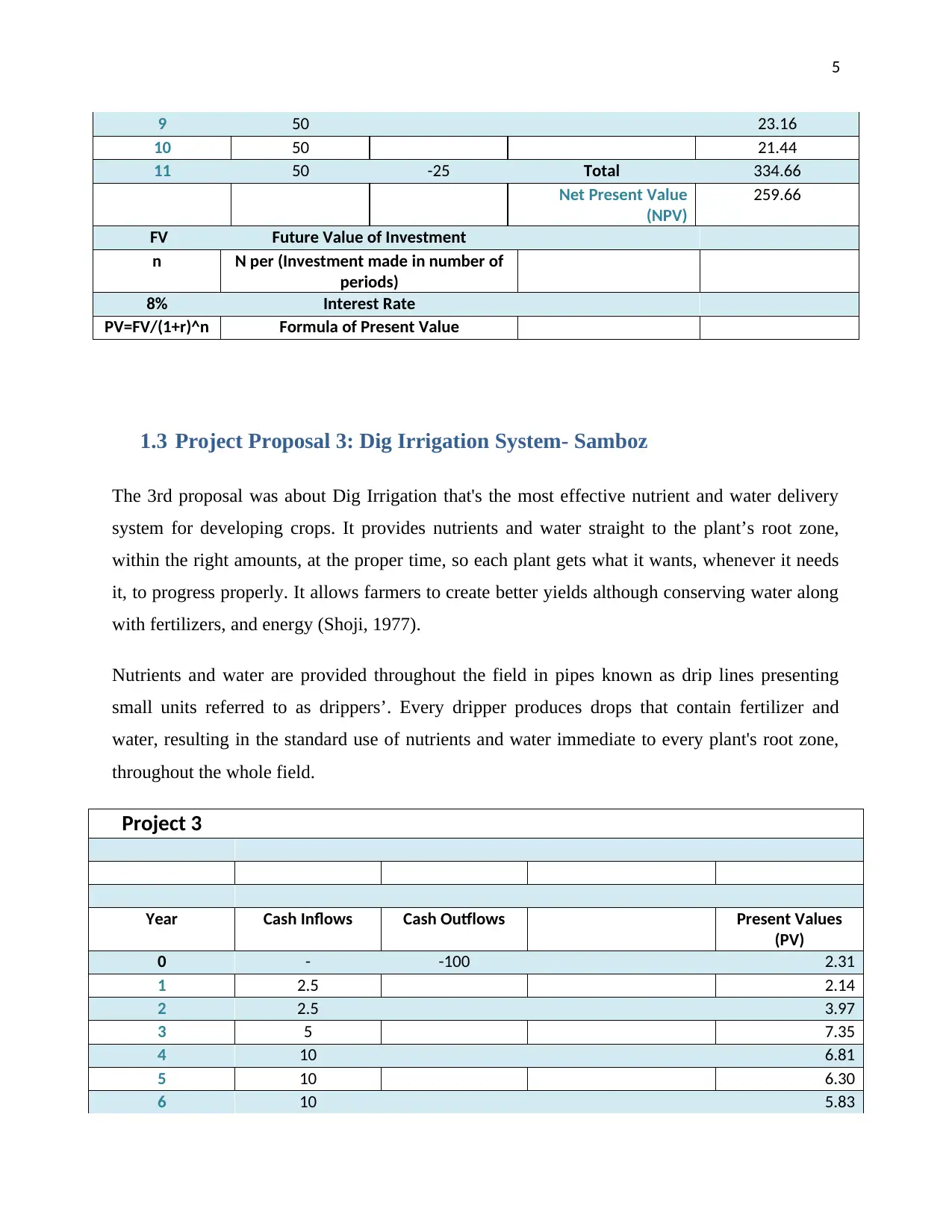
5
9 50 23.16
10 50 21.44
11 50 -25 Total 334.66
Net Present Value
(NPV)
259.66
FV Future Value of Investment
n N per (Investment made in number of
periods)
8% Interest Rate
PV=FV/(1+r)^n Formula of Present Value
1.3 Project Proposal 3: Dig Irrigation System- Samboz
The 3rd proposal was about Dig Irrigation that's the most effective nutrient and water delivery
system for developing crops. It provides nutrients and water straight to the plant’s root zone,
within the right amounts, at the proper time, so each plant gets what it wants, whenever it needs
it, to progress properly. It allows farmers to create better yields although conserving water along
with fertilizers, and energy (Shoji, 1977).
Nutrients and water are provided throughout the field in pipes known as drip lines presenting
small units referred to as drippers’. Every dripper produces drops that contain fertilizer and
water, resulting in the standard use of nutrients and water immediate to every plant's root zone,
throughout the whole field.
Project 3
Year Cash Inflows Cash Outflows Present Values
(PV)
0 - -100 2.31
1 2.5 2.14
2 2.5 3.97
3 5 7.35
4 10 6.81
5 10 6.30
6 10 5.83
9 50 23.16
10 50 21.44
11 50 -25 Total 334.66
Net Present Value
(NPV)
259.66
FV Future Value of Investment
n N per (Investment made in number of
periods)
8% Interest Rate
PV=FV/(1+r)^n Formula of Present Value
1.3 Project Proposal 3: Dig Irrigation System- Samboz
The 3rd proposal was about Dig Irrigation that's the most effective nutrient and water delivery
system for developing crops. It provides nutrients and water straight to the plant’s root zone,
within the right amounts, at the proper time, so each plant gets what it wants, whenever it needs
it, to progress properly. It allows farmers to create better yields although conserving water along
with fertilizers, and energy (Shoji, 1977).
Nutrients and water are provided throughout the field in pipes known as drip lines presenting
small units referred to as drippers’. Every dripper produces drops that contain fertilizer and
water, resulting in the standard use of nutrients and water immediate to every plant's root zone,
throughout the whole field.
Project 3
Year Cash Inflows Cash Outflows Present Values
(PV)
0 - -100 2.31
1 2.5 2.14
2 2.5 3.97
3 5 7.35
4 10 6.81
5 10 6.30
6 10 5.83
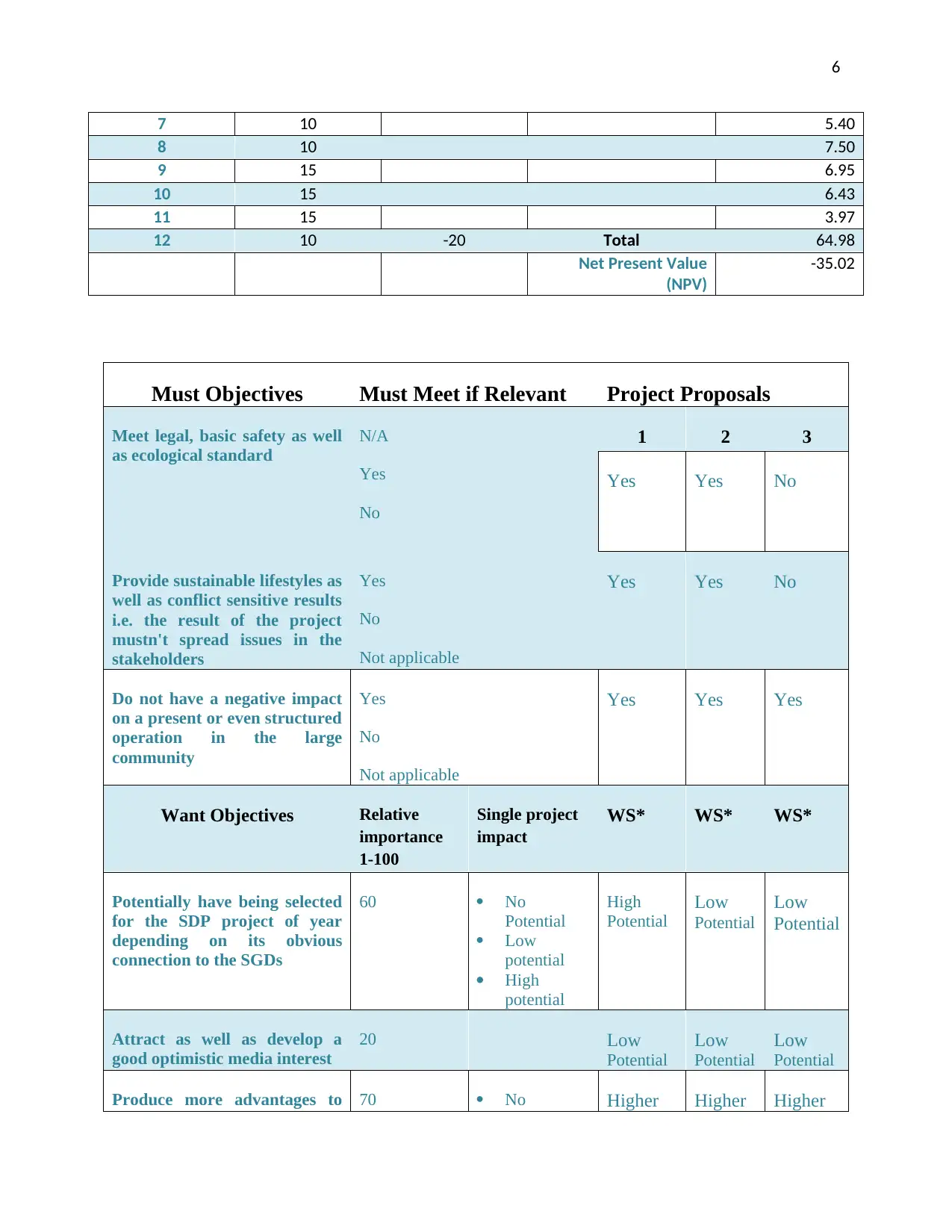
6
7 10 5.40
8 10 7.50
9 15 6.95
10 15 6.43
11 15 3.97
12 10 -20 Total 64.98
Net Present Value
(NPV)
-35.02
Must Objectives Must Meet if Relevant Project Proposals
Meet legal, basic safety as well
as ecological standard
N/A
Yes
No
1 2 3
Yes Yes No
Provide sustainable lifestyles as
well as conflict sensitive results
i.e. the result of the project
mustn't spread issues in the
stakeholders
Yes
No
Not applicable
Yes Yes No
Do not have a negative impact
on a present or even structured
operation in the large
community
Yes
No
Not applicable
Yes Yes Yes
Want Objectives Relative
importance
1-100
Single project
impact
WS* WS* WS*
Potentially have being selected
for the SDP project of year
depending on its obvious
connection to the SGDs
60 No
Potential
Low
potential
High
potential
High
Potential
Low
Potential
Low
Potential
Attract as well as develop a
good optimistic media interest
20 Low
Potential
Low
Potential
Low
Potential
Produce more advantages to 70 No Higher Higher Higher
7 10 5.40
8 10 7.50
9 15 6.95
10 15 6.43
11 15 3.97
12 10 -20 Total 64.98
Net Present Value
(NPV)
-35.02
Must Objectives Must Meet if Relevant Project Proposals
Meet legal, basic safety as well
as ecological standard
N/A
Yes
No
1 2 3
Yes Yes No
Provide sustainable lifestyles as
well as conflict sensitive results
i.e. the result of the project
mustn't spread issues in the
stakeholders
Yes
No
Not applicable
Yes Yes No
Do not have a negative impact
on a present or even structured
operation in the large
community
Yes
No
Not applicable
Yes Yes Yes
Want Objectives Relative
importance
1-100
Single project
impact
WS* WS* WS*
Potentially have being selected
for the SDP project of year
depending on its obvious
connection to the SGDs
60 No
Potential
Low
potential
High
potential
High
Potential
Low
Potential
Low
Potential
Attract as well as develop a
good optimistic media interest
20 Low
Potential
Low
Potential
Low
Potential
Produce more advantages to 70 No Higher Higher Higher
⊘ This is a preview!⊘
Do you want full access?
Subscribe today to unlock all pages.

Trusted by 1+ million students worldwide
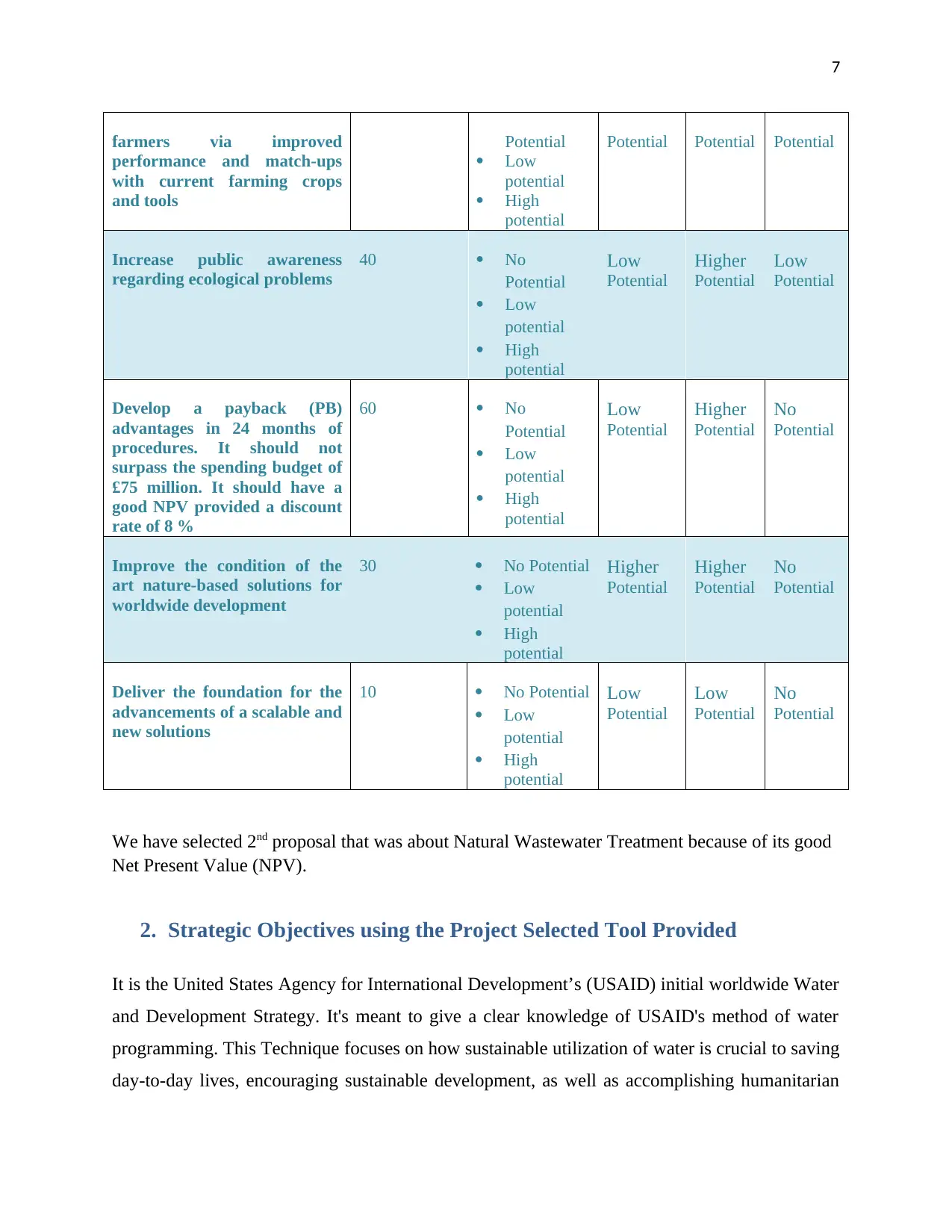
7
farmers via improved
performance and match-ups
with current farming crops
and tools
Potential
Low
potential
High
potential
Potential Potential Potential
Increase public awareness
regarding ecological problems
40 No
Potential
Low
potential
High
potential
Low
Potential
Higher
Potential
Low
Potential
Develop a payback (PB)
advantages in 24 months of
procedures. It should not
surpass the spending budget of
£75 million. It should have a
good NPV provided a discount
rate of 8 %
60 No
Potential
Low
potential
High
potential
Low
Potential
Higher
Potential
No
Potential
Improve the condition of the
art nature-based solutions for
worldwide development
30 No Potential
Low
potential
High
potential
Higher
Potential
Higher
Potential
No
Potential
Deliver the foundation for the
advancements of a scalable and
new solutions
10 No Potential
Low
potential
High
potential
Low
Potential
Low
Potential
No
Potential
We have selected 2nd proposal that was about Natural Wastewater Treatment because of its good
Net Present Value (NPV).
2. Strategic Objectives using the Project Selected Tool Provided
It is the United States Agency for International Development’s (USAID) initial worldwide Water
and Development Strategy. It's meant to give a clear knowledge of USAID's method of water
programming. This Technique focuses on how sustainable utilization of water is crucial to saving
day-to-day lives, encouraging sustainable development, as well as accomplishing humanitarian
farmers via improved
performance and match-ups
with current farming crops
and tools
Potential
Low
potential
High
potential
Potential Potential Potential
Increase public awareness
regarding ecological problems
40 No
Potential
Low
potential
High
potential
Low
Potential
Higher
Potential
Low
Potential
Develop a payback (PB)
advantages in 24 months of
procedures. It should not
surpass the spending budget of
£75 million. It should have a
good NPV provided a discount
rate of 8 %
60 No
Potential
Low
potential
High
potential
Low
Potential
Higher
Potential
No
Potential
Improve the condition of the
art nature-based solutions for
worldwide development
30 No Potential
Low
potential
High
potential
Higher
Potential
Higher
Potential
No
Potential
Deliver the foundation for the
advancements of a scalable and
new solutions
10 No Potential
Low
potential
High
potential
Low
Potential
Low
Potential
No
Potential
We have selected 2nd proposal that was about Natural Wastewater Treatment because of its good
Net Present Value (NPV).
2. Strategic Objectives using the Project Selected Tool Provided
It is the United States Agency for International Development’s (USAID) initial worldwide Water
and Development Strategy. It's meant to give a clear knowledge of USAID's method of water
programming. This Technique focuses on how sustainable utilization of water is crucial to saving
day-to-day lives, encouraging sustainable development, as well as accomplishing humanitarian
Paraphrase This Document
Need a fresh take? Get an instant paraphrase of this document with our AI Paraphraser
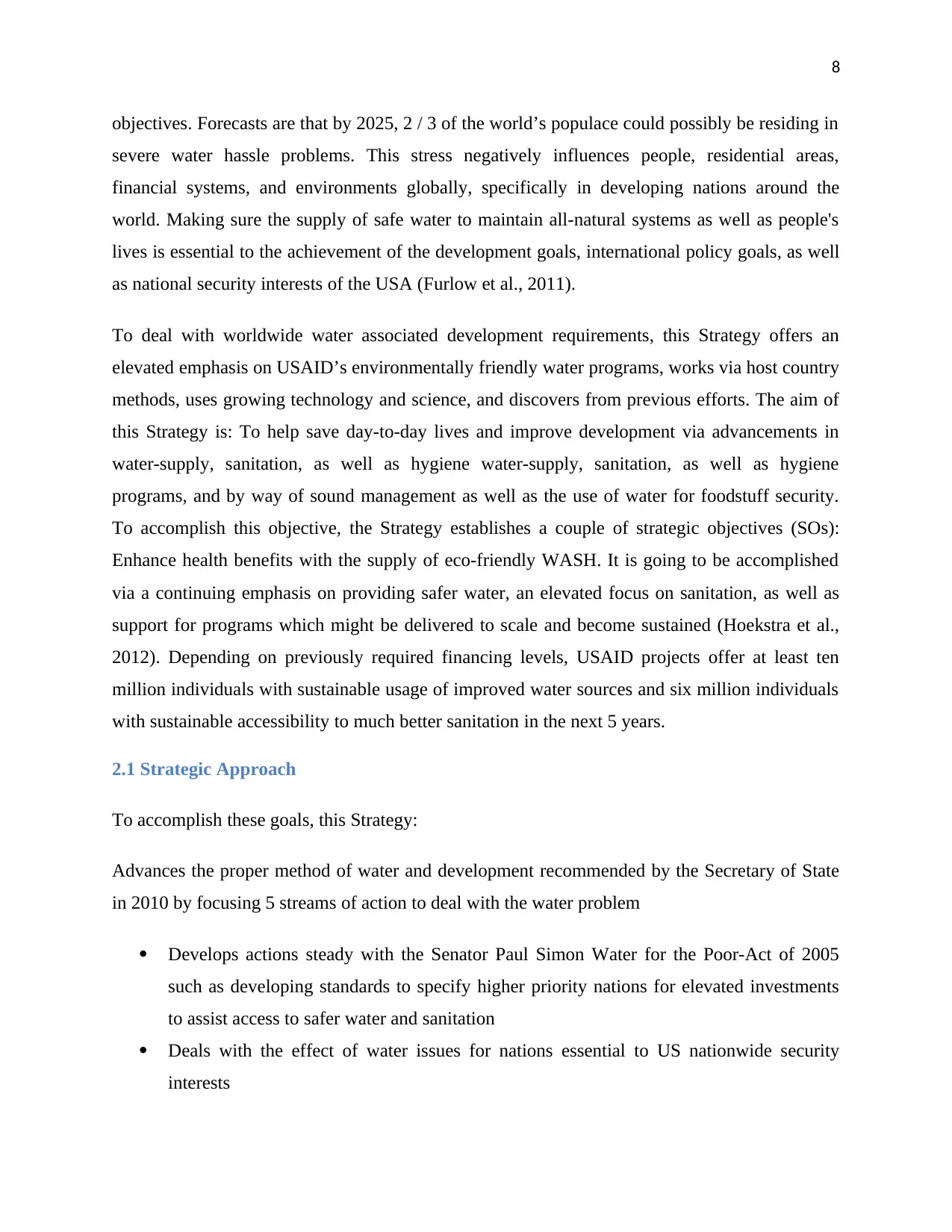
8
objectives. Forecasts are that by 2025, 2 / 3 of the world’s populace could possibly be residing in
severe water hassle problems. This stress negatively influences people, residential areas,
financial systems, and environments globally, specifically in developing nations around the
world. Making sure the supply of safe water to maintain all-natural systems as well as people's
lives is essential to the achievement of the development goals, international policy goals, as well
as national security interests of the USA (Furlow et al., 2011).
To deal with worldwide water associated development requirements, this Strategy offers an
elevated emphasis on USAID’s environmentally friendly water programs, works via host country
methods, uses growing technology and science, and discovers from previous efforts. The aim of
this Strategy is: To help save day-to-day lives and improve development via advancements in
water-supply, sanitation, as well as hygiene water-supply, sanitation, as well as hygiene
programs, and by way of sound management as well as the use of water for foodstuff security.
To accomplish this objective, the Strategy establishes a couple of strategic objectives (SOs):
Enhance health benefits with the supply of eco-friendly WASH. It is going to be accomplished
via a continuing emphasis on providing safer water, an elevated focus on sanitation, as well as
support for programs which might be delivered to scale and become sustained (Hoekstra et al.,
2012). Depending on previously required financing levels, USAID projects offer at least ten
million individuals with sustainable usage of improved water sources and six million individuals
with sustainable accessibility to much better sanitation in the next 5 years.
2.1 Strategic Approach
To accomplish these goals, this Strategy:
Advances the proper method of water and development recommended by the Secretary of State
in 2010 by focusing 5 streams of action to deal with the water problem
Develops actions steady with the Senator Paul Simon Water for the Poor-Act of 2005
such as developing standards to specify higher priority nations for elevated investments
to assist access to safer water and sanitation
Deals with the effect of water issues for nations essential to US nationwide security
interests
objectives. Forecasts are that by 2025, 2 / 3 of the world’s populace could possibly be residing in
severe water hassle problems. This stress negatively influences people, residential areas,
financial systems, and environments globally, specifically in developing nations around the
world. Making sure the supply of safe water to maintain all-natural systems as well as people's
lives is essential to the achievement of the development goals, international policy goals, as well
as national security interests of the USA (Furlow et al., 2011).
To deal with worldwide water associated development requirements, this Strategy offers an
elevated emphasis on USAID’s environmentally friendly water programs, works via host country
methods, uses growing technology and science, and discovers from previous efforts. The aim of
this Strategy is: To help save day-to-day lives and improve development via advancements in
water-supply, sanitation, as well as hygiene water-supply, sanitation, as well as hygiene
programs, and by way of sound management as well as the use of water for foodstuff security.
To accomplish this objective, the Strategy establishes a couple of strategic objectives (SOs):
Enhance health benefits with the supply of eco-friendly WASH. It is going to be accomplished
via a continuing emphasis on providing safer water, an elevated focus on sanitation, as well as
support for programs which might be delivered to scale and become sustained (Hoekstra et al.,
2012). Depending on previously required financing levels, USAID projects offer at least ten
million individuals with sustainable usage of improved water sources and six million individuals
with sustainable accessibility to much better sanitation in the next 5 years.
2.1 Strategic Approach
To accomplish these goals, this Strategy:
Advances the proper method of water and development recommended by the Secretary of State
in 2010 by focusing 5 streams of action to deal with the water problem
Develops actions steady with the Senator Paul Simon Water for the Poor-Act of 2005
such as developing standards to specify higher priority nations for elevated investments
to assist access to safer water and sanitation
Deals with the effect of water issues for nations essential to US nationwide security
interests
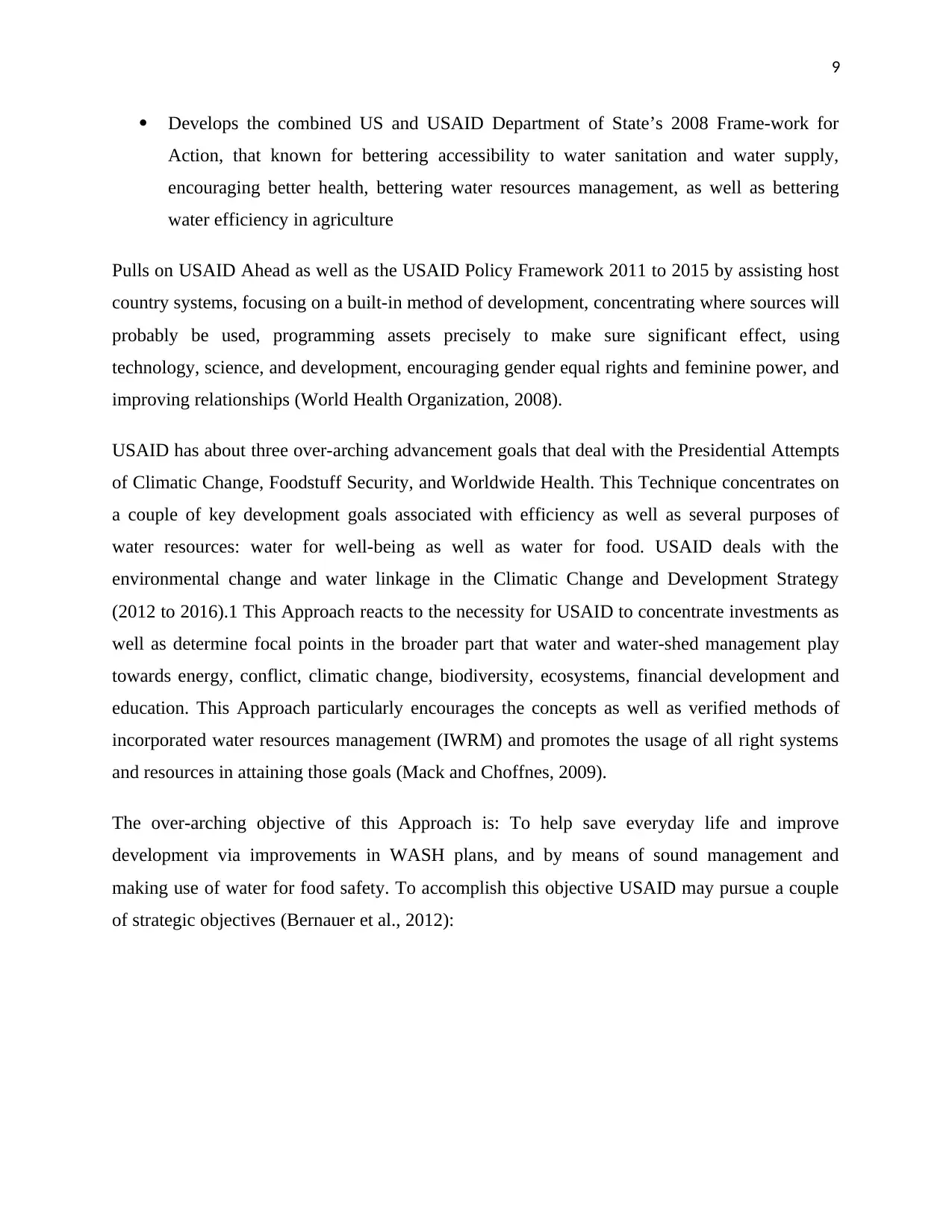
9
Develops the combined US and USAID Department of State’s 2008 Frame-work for
Action, that known for bettering accessibility to water sanitation and water supply,
encouraging better health, bettering water resources management, as well as bettering
water efficiency in agriculture
Pulls on USAID Ahead as well as the USAID Policy Framework 2011 to 2015 by assisting host
country systems, focusing on a built-in method of development, concentrating where sources will
probably be used, programming assets precisely to make sure significant effect, using
technology, science, and development, encouraging gender equal rights and feminine power, and
improving relationships (World Health Organization, 2008).
USAID has about three over-arching advancement goals that deal with the Presidential Attempts
of Climatic Change, Foodstuff Security, and Worldwide Health. This Technique concentrates on
a couple of key development goals associated with efficiency as well as several purposes of
water resources: water for well-being as well as water for food. USAID deals with the
environmental change and water linkage in the Climatic Change and Development Strategy
(2012 to 2016).1 This Approach reacts to the necessity for USAID to concentrate investments as
well as determine focal points in the broader part that water and water-shed management play
towards energy, conflict, climatic change, biodiversity, ecosystems, financial development and
education. This Approach particularly encourages the concepts as well as verified methods of
incorporated water resources management (IWRM) and promotes the usage of all right systems
and resources in attaining those goals (Mack and Choffnes, 2009).
The over-arching objective of this Approach is: To help save everyday life and improve
development via improvements in WASH plans, and by means of sound management and
making use of water for food safety. To accomplish this objective USAID may pursue a couple
of strategic objectives (Bernauer et al., 2012):
Develops the combined US and USAID Department of State’s 2008 Frame-work for
Action, that known for bettering accessibility to water sanitation and water supply,
encouraging better health, bettering water resources management, as well as bettering
water efficiency in agriculture
Pulls on USAID Ahead as well as the USAID Policy Framework 2011 to 2015 by assisting host
country systems, focusing on a built-in method of development, concentrating where sources will
probably be used, programming assets precisely to make sure significant effect, using
technology, science, and development, encouraging gender equal rights and feminine power, and
improving relationships (World Health Organization, 2008).
USAID has about three over-arching advancement goals that deal with the Presidential Attempts
of Climatic Change, Foodstuff Security, and Worldwide Health. This Technique concentrates on
a couple of key development goals associated with efficiency as well as several purposes of
water resources: water for well-being as well as water for food. USAID deals with the
environmental change and water linkage in the Climatic Change and Development Strategy
(2012 to 2016).1 This Approach reacts to the necessity for USAID to concentrate investments as
well as determine focal points in the broader part that water and water-shed management play
towards energy, conflict, climatic change, biodiversity, ecosystems, financial development and
education. This Approach particularly encourages the concepts as well as verified methods of
incorporated water resources management (IWRM) and promotes the usage of all right systems
and resources in attaining those goals (Mack and Choffnes, 2009).
The over-arching objective of this Approach is: To help save everyday life and improve
development via improvements in WASH plans, and by means of sound management and
making use of water for food safety. To accomplish this objective USAID may pursue a couple
of strategic objectives (Bernauer et al., 2012):
⊘ This is a preview!⊘
Do you want full access?
Subscribe today to unlock all pages.

Trusted by 1+ million students worldwide
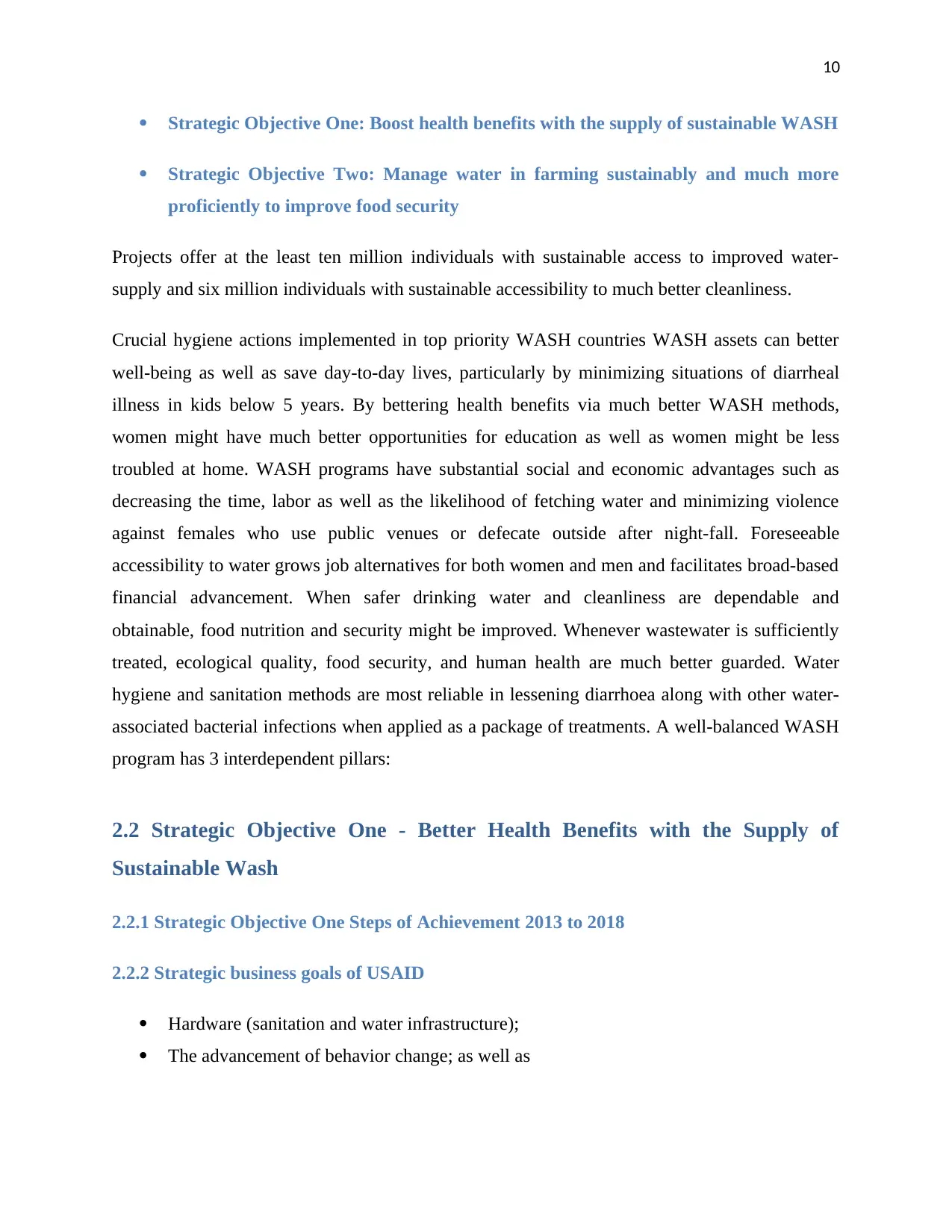
10
Strategic Objective One: Boost health benefits with the supply of sustainable WASH
Strategic Objective Two: Manage water in farming sustainably and much more
proficiently to improve food security
Projects offer at the least ten million individuals with sustainable access to improved water-
supply and six million individuals with sustainable accessibility to much better cleanliness.
Crucial hygiene actions implemented in top priority WASH countries WASH assets can better
well-being as well as save day-to-day lives, particularly by minimizing situations of diarrheal
illness in kids below 5 years. By bettering health benefits via much better WASH methods,
women might have much better opportunities for education as well as women might be less
troubled at home. WASH programs have substantial social and economic advantages such as
decreasing the time, labor as well as the likelihood of fetching water and minimizing violence
against females who use public venues or defecate outside after night-fall. Foreseeable
accessibility to water grows job alternatives for both women and men and facilitates broad-based
financial advancement. When safer drinking water and cleanliness are dependable and
obtainable, food nutrition and security might be improved. Whenever wastewater is sufficiently
treated, ecological quality, food security, and human health are much better guarded. Water
hygiene and sanitation methods are most reliable in lessening diarrhoea along with other water-
associated bacterial infections when applied as a package of treatments. A well-balanced WASH
program has 3 interdependent pillars:
2.2 Strategic Objective One - Better Health Benefits with the Supply of
Sustainable Wash
2.2.1 Strategic Objective One Steps of Achievement 2013 to 2018
2.2.2 Strategic business goals of USAID
Hardware (sanitation and water infrastructure);
The advancement of behavior change; as well as
Strategic Objective One: Boost health benefits with the supply of sustainable WASH
Strategic Objective Two: Manage water in farming sustainably and much more
proficiently to improve food security
Projects offer at the least ten million individuals with sustainable access to improved water-
supply and six million individuals with sustainable accessibility to much better cleanliness.
Crucial hygiene actions implemented in top priority WASH countries WASH assets can better
well-being as well as save day-to-day lives, particularly by minimizing situations of diarrheal
illness in kids below 5 years. By bettering health benefits via much better WASH methods,
women might have much better opportunities for education as well as women might be less
troubled at home. WASH programs have substantial social and economic advantages such as
decreasing the time, labor as well as the likelihood of fetching water and minimizing violence
against females who use public venues or defecate outside after night-fall. Foreseeable
accessibility to water grows job alternatives for both women and men and facilitates broad-based
financial advancement. When safer drinking water and cleanliness are dependable and
obtainable, food nutrition and security might be improved. Whenever wastewater is sufficiently
treated, ecological quality, food security, and human health are much better guarded. Water
hygiene and sanitation methods are most reliable in lessening diarrhoea along with other water-
associated bacterial infections when applied as a package of treatments. A well-balanced WASH
program has 3 interdependent pillars:
2.2 Strategic Objective One - Better Health Benefits with the Supply of
Sustainable Wash
2.2.1 Strategic Objective One Steps of Achievement 2013 to 2018
2.2.2 Strategic business goals of USAID
Hardware (sanitation and water infrastructure);
The advancement of behavior change; as well as
Paraphrase This Document
Need a fresh take? Get an instant paraphrase of this document with our AI Paraphraser
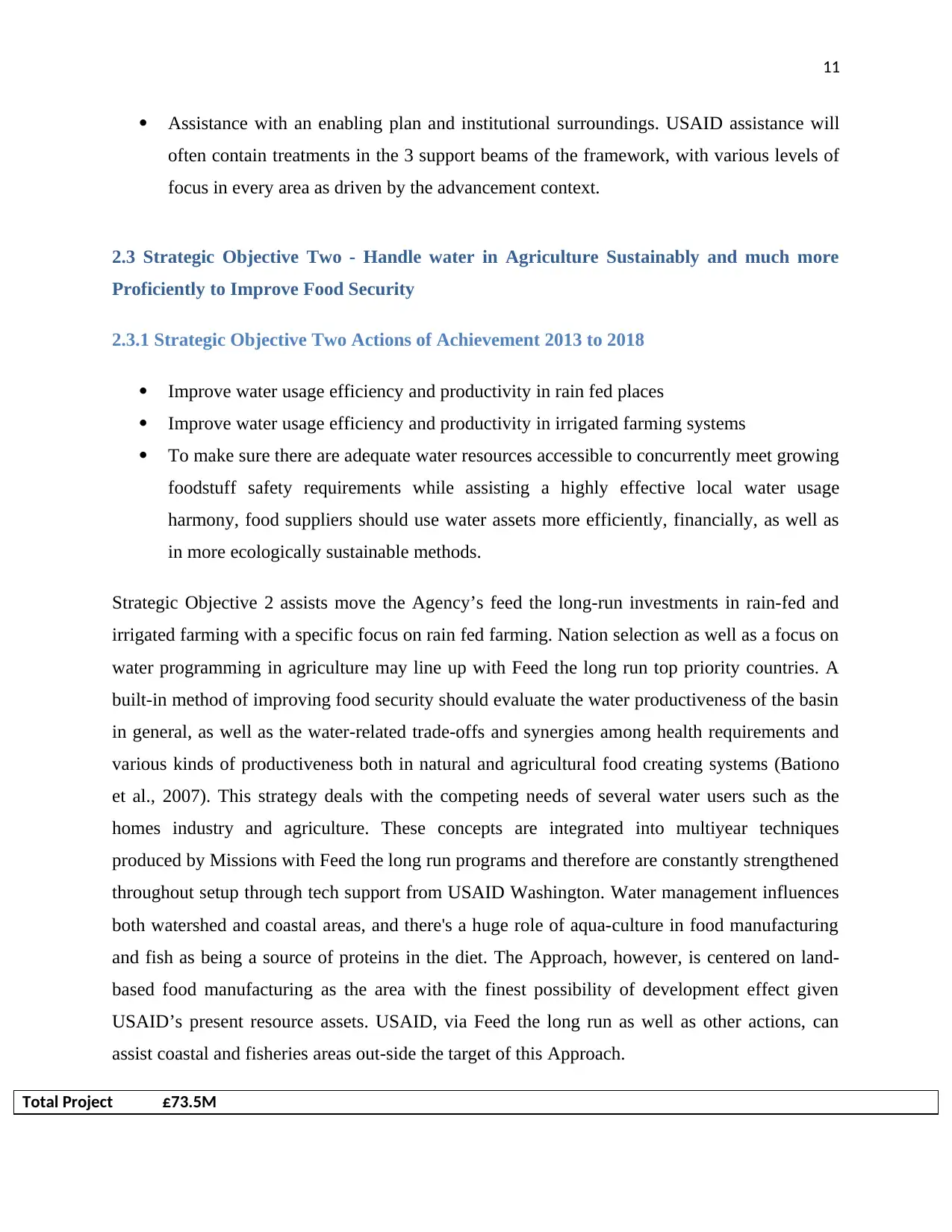
11
Assistance with an enabling plan and institutional surroundings. USAID assistance will
often contain treatments in the 3 support beams of the framework, with various levels of
focus in every area as driven by the advancement context.
2.3 Strategic Objective Two - Handle water in Agriculture Sustainably and much more
Proficiently to Improve Food Security
2.3.1 Strategic Objective Two Actions of Achievement 2013 to 2018
Improve water usage efficiency and productivity in rain fed places
Improve water usage efficiency and productivity in irrigated farming systems
To make sure there are adequate water resources accessible to concurrently meet growing
foodstuff safety requirements while assisting a highly effective local water usage
harmony, food suppliers should use water assets more efficiently, financially, as well as
in more ecologically sustainable methods.
Strategic Objective 2 assists move the Agency’s feed the long-run investments in rain-fed and
irrigated farming with a specific focus on rain fed farming. Nation selection as well as a focus on
water programming in agriculture may line up with Feed the long run top priority countries. A
built-in method of improving food security should evaluate the water productiveness of the basin
in general, as well as the water-related trade-offs and synergies among health requirements and
various kinds of productiveness both in natural and agricultural food creating systems (Bationo
et al., 2007). This strategy deals with the competing needs of several water users such as the
homes industry and agriculture. These concepts are integrated into multiyear techniques
produced by Missions with Feed the long run programs and therefore are constantly strengthened
throughout setup through tech support from USAID Washington. Water management influences
both watershed and coastal areas, and there's a huge role of aqua-culture in food manufacturing
and fish as being a source of proteins in the diet. The Approach, however, is centered on land-
based food manufacturing as the area with the finest possibility of development effect given
USAID’s present resource assets. USAID, via Feed the long run as well as other actions, can
assist coastal and fisheries areas out-side the target of this Approach.
Total Project £73.5M
Assistance with an enabling plan and institutional surroundings. USAID assistance will
often contain treatments in the 3 support beams of the framework, with various levels of
focus in every area as driven by the advancement context.
2.3 Strategic Objective Two - Handle water in Agriculture Sustainably and much more
Proficiently to Improve Food Security
2.3.1 Strategic Objective Two Actions of Achievement 2013 to 2018
Improve water usage efficiency and productivity in rain fed places
Improve water usage efficiency and productivity in irrigated farming systems
To make sure there are adequate water resources accessible to concurrently meet growing
foodstuff safety requirements while assisting a highly effective local water usage
harmony, food suppliers should use water assets more efficiently, financially, as well as
in more ecologically sustainable methods.
Strategic Objective 2 assists move the Agency’s feed the long-run investments in rain-fed and
irrigated farming with a specific focus on rain fed farming. Nation selection as well as a focus on
water programming in agriculture may line up with Feed the long run top priority countries. A
built-in method of improving food security should evaluate the water productiveness of the basin
in general, as well as the water-related trade-offs and synergies among health requirements and
various kinds of productiveness both in natural and agricultural food creating systems (Bationo
et al., 2007). This strategy deals with the competing needs of several water users such as the
homes industry and agriculture. These concepts are integrated into multiyear techniques
produced by Missions with Feed the long run programs and therefore are constantly strengthened
throughout setup through tech support from USAID Washington. Water management influences
both watershed and coastal areas, and there's a huge role of aqua-culture in food manufacturing
and fish as being a source of proteins in the diet. The Approach, however, is centered on land-
based food manufacturing as the area with the finest possibility of development effect given
USAID’s present resource assets. USAID, via Feed the long run as well as other actions, can
assist coastal and fisheries areas out-side the target of this Approach.
Total Project £73.5M
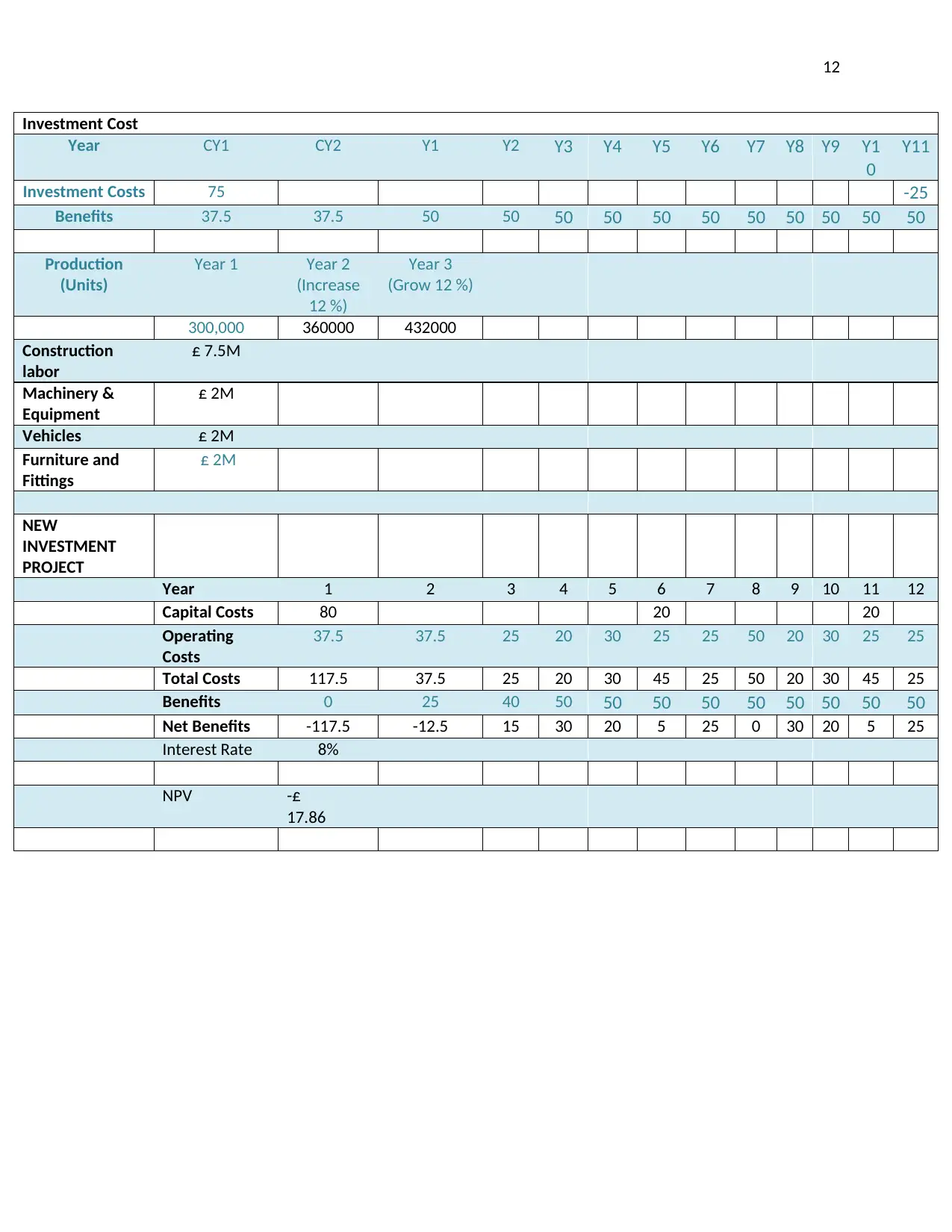
12
Investment Cost
Year CY1 CY2 Y1 Y2 Y3 Y4 Y5 Y6 Y7 Y8 Y9 Y1
0
Y11
Investment Costs 75 -25
Benefits 37.5 37.5 50 50 50 50 50 50 50 50 50 50 50
Production
(Units)
Year 1 Year 2
(Increase
12 %)
Year 3
(Grow 12 %)
300,000 360000 432000
Construction
labor
£ 7.5M
Machinery &
Equipment
£ 2M
Vehicles £ 2M
Furniture and
Fittings
£ 2M
NEW
INVESTMENT
PROJECT
Year 1 2 3 4 5 6 7 8 9 10 11 12
Capital Costs 80 20 20
Operating
Costs
37.5 37.5 25 20 30 25 25 50 20 30 25 25
Total Costs 117.5 37.5 25 20 30 45 25 50 20 30 45 25
Benefits 0 25 40 50 50 50 50 50 50 50 50 50
Net Benefits -117.5 -12.5 15 30 20 5 25 0 30 20 5 25
Interest Rate 8%
NPV -£
17.86
Investment Cost
Year CY1 CY2 Y1 Y2 Y3 Y4 Y5 Y6 Y7 Y8 Y9 Y1
0
Y11
Investment Costs 75 -25
Benefits 37.5 37.5 50 50 50 50 50 50 50 50 50 50 50
Production
(Units)
Year 1 Year 2
(Increase
12 %)
Year 3
(Grow 12 %)
300,000 360000 432000
Construction
labor
£ 7.5M
Machinery &
Equipment
£ 2M
Vehicles £ 2M
Furniture and
Fittings
£ 2M
NEW
INVESTMENT
PROJECT
Year 1 2 3 4 5 6 7 8 9 10 11 12
Capital Costs 80 20 20
Operating
Costs
37.5 37.5 25 20 30 25 25 50 20 30 25 25
Total Costs 117.5 37.5 25 20 30 45 25 50 20 30 45 25
Benefits 0 25 40 50 50 50 50 50 50 50 50 50
Net Benefits -117.5 -12.5 15 30 20 5 25 0 30 20 5 25
Interest Rate 8%
NPV -£
17.86
⊘ This is a preview!⊘
Do you want full access?
Subscribe today to unlock all pages.

Trusted by 1+ million students worldwide
1 out of 17
Your All-in-One AI-Powered Toolkit for Academic Success.
+13062052269
info@desklib.com
Available 24*7 on WhatsApp / Email
![[object Object]](/_next/static/media/star-bottom.7253800d.svg)
Unlock your academic potential
Copyright © 2020–2025 A2Z Services. All Rights Reserved. Developed and managed by ZUCOL.